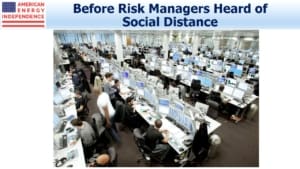Energy Markets Are Adapting Quickly
Coronavirus approached us like a distant wave earlier this year. Initially it was remote and unthreatening, as we viewed developments far away in Asia. But it soon engulfed us, making our lives unrecognizable and crushing economic activity everywhere. As the first wave recedes, individuals and businesses are adapting to the new normal, while contemplating a second one later this year.
Demand for transportation collapsed, with global crude oil demand down a record 25% in April. Working remotely has been far less disruptive than many expected. While it’s probably now a permanent feature, I suspect most businesses will adopt a hybrid model. In-depth discussions, training and relationship building are all richer in person, when conditions allow.
Brazil’s Petrobras plans to keep half its administrative staff working from home permanently, one of the first big companies to make such an announcement. This will impact over 10,000 employees. A new risk for large businesses is the possibility that an entire department could be incapacitated by a virus super spreader – and even after we’ve vanquished Covid-19, the hypothetical risk of a new virus will remain. Imagine the trading room of a global bank becoming infected. Traders can work remotely, but that presumes they’re not already sick. A dispersed department is a safer one. Downtown real estate owners shudder. In the future, every business meeting will need to be of sufficient value to justify a possible exposure.
Aviation is years away from a return to normalcy. Qantas has now pushed back the resumption of international flights until at least October. Passenger volume through TSA checkpoints remains down 83% from a year ago.
Electric vehicles are not immune to weaker demand either. Sales of rechargeable batteries are forecast to fall for the first time in history, by 14% this year.
The energy sector is adapting. After losing over half its value through mid-March, the North American pipeline sector is the new momentum play, easily outperforming the overall market on the rebound. The International Energy Agency recently forecast that crude demand in 2021 will jump by 5.7 Million Barrels per Day (MMB/D), recouping two thirds of this year’s projected drop of 8.1 MMB/D. U.S. shale production, which dropped by 2 MMB/D during the lockdown, is expected to recover a quarter of this drop by the end of the month.
The increase in Free Cash Flow (FCF) at pipelines is a result of lower spending on new projects (see Pipeline Cash Flows Will Still Double This Year). Similarly, upstream investment is also slowing. Goldman Sachs expects capex for big oil projects to halve over the next couple of years, and fall by a third for liquefied natural gas. This structural under-investment will mean less new non-OPEC supply in the coming years, which Goldman argues will cause a multi-year cyclical upswing in commodity prices and better returns on invested capital. As energy investors, the last few years of poor returns have led us to regard almost any reduction in growth capex positively.
BP took a $17.5BN writedown as they expect oil demand to remain on a permanently lower trajectory. They were still able to raise $12BN in hybrid debt, equity-like securities which give BP the option to repay but may be perpetual. With coupons as low as 3.25%, there was clearly strong demand.
Lower crude oil production in the Permian in west Texas has reduced flaring, since less associated gas is being produced as well. The Texas Railroad Commission (RRC) is exploring ways they could limit flaring – since they’ve never rejected a flaring application, they are hardly a vigorous enforcer. Now at least one commissioner is considering the reputational harm flaring causes, which is at least a step in the right direction. We have long called for greater control (see Texas Reconsiders Flaring, listen to Stop Flaring Natural Gas and watch Stop Flaring).
Businesses are adapting, and the brisk recovery in economic activity is helping. The new normal is almost here.
